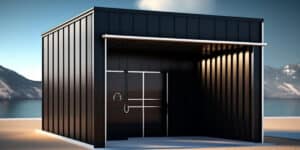Why Shipping Container Garages are the Perfect Solution for Your Storage Needs
Are you in need of extra storage space? Do you have valuable items that need protection from the elements? Look no further than shipping container garages! These versatile structures are not only a practical and cost-effective storage solution but also offer a range of benefits that make them the perfect choice for your storage needs.
Durable and Secure
One of the key advantages of using shipping containers as garages is their exceptional durability. Built to withstand the harsh conditions of international shipping, these containers are made from highly durable steel. This means that they can withstand extreme weather conditions, including heavy rain, strong winds, and even earthquakes.
Furthermore, shipping containers are designed with security in mind. Equipped with lockable doors and made from tough materials, they provide a secure space to store your belongings. Whether you need to store household items, equipment, or even vehicles, you can have peace of mind knowing that your possessions are safe from theft and vandalism.
Customizable and Flexible
Another great aspect of shipping container garages is their versatility. These containers can be easily modified and customized to suit your specific storage needs. With a wide range of sizes available, you can choose the container that best fits your requirements.
Containers can also be modified with additional features such as windows, ventilation systems, insulation, and lighting. This allows you to create a comfortable and functional space that can be used for various purposes. Whether you need a workshop, a home office, or simply a place to store your belongings, shipping containers can be tailored to meet your unique needs.
Cost-Effective
Compared to traditional brick-and-mortar structures, shipping container garages offer a cost-effective storage solution. Purchasing a new container or even opting for a used one can be significantly more affordable than constructing a permanent storage building.
Additionally, these containers can be easily transported and relocated if needed, making them a cost-effective choice for both short-term and long-term storage solutions. They also require minimal maintenance, saving you both time and money in the long run.
Environmentally Friendly
In today’s eco-conscious world, finding sustainable solutions is more important than ever. Shipping container garages are an environmentally friendly choice for your storage needs. By repurposing and reusing these containers, you are reducing waste and minimizing the demand for new construction materials.
Furthermore, shipping containers can be recycled at the end of their lifespan, ensuring that they do not contribute to landfill waste. Choosing a shipping container garage not only provides you with a practical storage solution but also allows you to make a positive impact on the environment.
Conclusion
When it comes to finding the perfect storage solution, shipping container garages tick all the boxes. They offer durability, security, customization options, and cost-effectiveness, while also being environmentally friendly. Whether you need extra storage space for personal or business use, shipping container garages provide a practical and versatile solution. So, why settle for traditional storage options when you can have a shipping container garage that meets all your needs? Invest in a shipping container garage today and enjoy the benefits of a secure, customizable, and cost-effective storage solution.
How Shipping Container Garages are Revolutionizing the Home Improvement Industry
In recent years, there has been a growing trend in the home improvement industry – the use of shipping containers as an innovative alternative to traditional garages. This trend has gained popularity due to the numerous benefits that shipping container garages offer. From cost-effectiveness to sustainability, these versatile structures are revolutionizing the way we think about home improvement.
Cost-Effective and Efficient
One of the primary reasons why shipping container garages are gaining traction is their cost-effectiveness. Constructing a traditional garage can be a costly endeavor, involving the need for extensive materials and labor. In contrast, repurposing a shipping container into a garage significantly reduces the cost of construction.
Shipping containers are readily available and relatively affordable. By repurposing these containers, homeowners can save a substantial amount of money compared to building a traditional garage from scratch. Additionally, the modular nature of shipping containers allows for easy expansion or relocation if needed, making them a flexible and efficient choice.
Sustainability and Eco-Friendliness
With the increasing concerns about the environment, sustainability has become a priority for many homeowners. Shipping container garages align perfectly with this mindset. By repurposing these containers, we are reducing waste and giving them a new purpose.
Moreover, shipping containers are made from sturdy materials, designed to withstand harsh conditions during transportation. This durability translates into a garage that can withstand the test of time, reducing the need for frequent maintenance or replacement. As a result, shipping container garages have a longer lifespan than traditional garages, making them a more sustainable choice in the long run.
Versatility and Customization
Shipping container garages offer a level of versatility and customization that traditional garages often lack. These containers can be easily modified to suit various needs and preferences. Whether you require additional storage space, a workshop, or a home gym, shipping containers can be transformed to meet your specific requirements.
Furthermore, the exterior of shipping containers can be modified to match the aesthetics of your home, allowing for a seamless integration into your property. From adding windows and doors to installing insulation and electrical systems, the possibilities for customization are virtually endless.
Portability and Accessibility
Another key advantage of shipping container garages is their portability. Unlike traditional garages, which are fixed structures, shipping containers can be easily transported and relocated if necessary. This flexibility is particularly beneficial for those who frequently move or for individuals who want the option to take their garage with them when they relocate.
Moreover, shipping container garages are designed for accessibility. With the ability to add ramps, stairs, and other accessibility features, these garages can accommodate the needs of individuals with disabilities. This makes them a practical choice for homeowners who require accessible storage or workspace.
Conclusion
Shipping container garages have undoubtedly revolutionized the home improvement industry. With their cost-effectiveness, sustainability, versatility, and portability, they offer a compelling alternative to traditional garages. Whether you are looking to save money, reduce waste, or customize your space, shipping container garages provide an innovative solution that is transforming the way we approach home improvement. As this trend continues to grow, it’s clear that shipping container garages are here to stay.
From Storage to Style: How Shipping Container Garages Are Redefining Modern Architecture
In the world of modern architecture, creativity and innovation are constantly pushing the boundaries of what is possible. From sustainable designs to repurposed materials, architects and designers are finding new ways to redefine our living spaces. One such trend that has been gaining popularity in recent years is the use of shipping containers in construction projects. These versatile and durable structures are no longer limited to just storage; they are now being transformed into stylish and functional garages.
The Rise of Shipping Container Garages
Shipping containers have long been used for their practicality and affordability in the transportation industry. However, their potential as building materials was realized by architects and designers who saw the opportunity to repurpose these containers into habitable spaces. This led to the rise of shipping container homes and offices, and now the trend has extended to garages.
The Benefits of Shipping Container Garages
1. Affordability
One of the main advantages of shipping container garages is their cost-effectiveness. Compared to traditional construction methods, repurposing shipping containers can be significantly cheaper. The containers themselves are readily available and can be purchased at a fraction of the cost of traditional building materials. Additionally, the construction process is generally quicker, resulting in reduced labor costs.
2. Durability
Shipping containers are built to withstand harsh conditions at sea, making them incredibly durable structures. They are made from weather-resistant steel, designed to resist corrosion, and are built to withstand extreme winds and heavy loads. This means that a shipping container garage will not only be able to protect your vehicles but will also stand the test of time.
3. Versatility
Shipping containers offer a great deal of versatility in terms of design and layout. They can be easily modified to suit individual needs and preferences. Whether you need a single-car garage or a multi-car showroom, shipping containers can be stacked, combined, or modified to create the desired space. The modular nature of shipping containers also allows for easy expansion or relocation if needed in the future.
4. Sustainability
Repurposing shipping containers for garages is an eco-friendly choice. By utilizing existing containers, you are reducing the demand for new construction materials. Shipping containers also have a lower carbon footprint compared to traditional building materials, as their production requires less energy and resources. Additionally, repurposing containers helps to reduce waste in landfills.
Innovative Designs and Features
The use of shipping containers in garage construction has sparked a wave of creativity among architects and designers. They are increasingly incorporating unique and stylish features to enhance the aesthetic appeal of these structures. From adding windows, skylights, and glass doors to installing green roofs and rooftop gardens, shipping container garages can be transformed into architectural masterpieces.
Furthermore, the interior can be customized with insulation, ventilation systems, and lighting to create a comfortable and functional space. Many container garages also integrate storage solutions, workspaces, and recreational areas, making them more than just a place to park your vehicles.
Conclusion
Shipping container garages have emerged as a unique and innovative solution in modern architecture. They offer affordability, durability, versatility, and sustainability, making them an attractive option for homeowners and businesses alike. With their potential for creative design and customization, these garages are redefining the concept of functional and stylish architecture. So, if you’re looking for a garage that stands out from the rest, consider the possibilities of a shipping container garage.
The Ultimate Guide to Building Your Dream Shipping Container Garage
Are you in need of extra space for storage, a workshop, or even a place to park your vehicles? Look no further than a shipping container garage! Not only are shipping containers readily available and affordable, but they also provide a durable and versatile solution for all your garage needs. In this ultimate guide, we will walk you through the process of building your dream shipping container garage.
Step 1: Planning and Designing
Before you dive into the construction process, it’s essential to spend time planning and designing your shipping container garage. Consider the following factors:
Purpose and Functionality
What will you be using your garage for? Will it serve as a simple storage space or as a multifunctional workshop? Determining its purpose will help you decide on the size, layout, and necessary features.
Size and Dimensions
Measure the available space on your property and determine how many shipping containers will fit comfortably. Standard shipping containers come in various sizes, with the most common being 20 feet and 40 feet in length. Consider the height and width as well, as this will impact the overall space you have to work with.
Permits and Regulations
Check with your local authorities to understand any building permits or regulations you need to adhere to. Some areas may have restrictions on the use of shipping containers or require specific modifications for safety and structural integrity.
Layout and Design
Create a layout that suits your needs. Consider factors such as vehicle access, storage requirements, electrical outlets, windows for natural light, and ventilation. Sketch out your ideal floor plan, keeping in mind the container’s structural limitations.
Step 2: Sourcing and Preparing the Shipping Container
Once you have your design plan in place, it’s time to source your shipping container(s) and prepare them for construction.
Sourcing
Look for reputable suppliers in your area or online platforms specializing in selling used shipping containers. Inspect the containers thoroughly for any signs of damage, corrosion, or structural issues. Opt for containers made of corten steel, known for its durability and resistance to rust.
Preparing the Container
Before you start building, prepare the container by cleaning it thoroughly and removing any existing flooring or internal wall structures. Consider adding insulation to regulate temperature and minimize condensation.
Step 3: Foundation and Site Preparation
A solid foundation is crucial for the stability and longevity of your shipping container garage.
Foundation Options
There are several foundation options to consider, such as concrete slabs, concrete footings, or a raised platform. Consult with a professional to determine the best choice for your specific location and soil conditions.
Site Preparation
Clear the site of any debris, level the ground, and ensure proper drainage. Make sure the site is easily accessible for construction equipment and future use.
Step 4: Construction and Modifications
Now it’s time to bring your dream shipping container garage to life!
Structural Integrity
Ensure the shipping container is structurally sound. Reinforce weak points, such as the corners and door frames, by adding extra steel supports or welding reinforcements.
Doors and Windows
Cut openings for doors and windows based on your design plan. Install sturdy, weather-resistant doors and windows that provide security and allow natural light to enter.
Electrical and Plumbing
If you plan to use your garage as a workshop or for other activities requiring electricity and plumbing, consult with professionals to handle these installations safely and efficiently.
Insulation and Ventilation
Insulate your shipping container garage to regulate temperature and minimize energy consumption. Consider using spray foam insulation or insulating panels. Install proper ventilation systems to prevent moisture buildup and improve air circulation.
Step 5: Interior Finishing and Customization
The final step is to personalize your shipping container garage to suit your needs and aesthetic preferences.
Flooring
Choose a durable and easy-to-maintain flooring option, such as epoxy or polished concrete. Alternatively, you can install wooden or vinyl flooring for a more comfortable feel.
Shelving and Storage
Maximize your storage space by installing shelves, cabinets, or pegboards. Customizable storage solutions will help keep your garage organized and clutter-free.
Lighting and Decor
Install adequate lighting fixtures to ensure your garage is well-lit and functional. Consider adding decorative elements that reflect your personality and create a pleasant working environment.
Conclusion
Building your dream shipping container garage is an exciting project that offers endless possibilities. With proper planning, sourcing, and construction, you can transform a simple shipping container into a functional and stylish space that meets all your garage needs. Take your time, consult professionals when needed, and enjoy the process of creating a unique and versatile garage that will serve you for years to come.
Transforming Your Backyard with a Shipping Container Garage: A Step-by-Step Guide
Are you looking for a creative way to make the most of your backyard space? Consider transforming a shipping container into a garage! Not only is this a unique and eco-friendly solution, but it also offers a plethora of possibilities for storage, a workshop, a home gym, or even a studio. In this step-by-step guide, we will walk you through the process of transforming your backyard with a shipping container garage.
Step 1: Planning and Designing
Before diving into the project, it’s important to have a clear plan and design in mind. Determine the purpose of your garage and how you envision utilizing the space. Consider factors such as size, layout, and any additional features you would like to incorporate. Sketch out your ideas or work with a professional designer to bring your vision to life.
Step 2: Choosing the Right Shipping Container
The next step is finding the perfect shipping container for your garage. Consider factors such as size, condition, and budget. Shipping containers come in various sizes, including 20-foot and 40-foot options. It’s essential to assess the condition of the container to ensure it is structurally sound and free from any damage or rust. Additionally, decide whether you want a new or used container, as this will affect the cost.
Step 3: Preparing the Site
Once you have acquired your shipping container, it’s time to prepare the site in your backyard. Clear the area of any debris, vegetation, or obstacles that may hinder the installation process. Ensure that the ground is level and stable to provide a solid foundation for your garage. Consider hiring a professional to assist with site preparation if needed.
Step 4: Permits and Regulations
Before proceeding with the installation, check with your local authorities to determine if any permits or regulations apply to shipping container structures in your area. Some municipalities have specific requirements regarding setbacks, height restrictions, and aesthetics. By obtaining the necessary permits and adhering to regulations, you can avoid any potential issues in the future.
Step 5: Foundation and Anchoring
To ensure stability and longevity, it’s crucial to establish a solid foundation for your shipping container garage. Options include a concrete slab, gravel, or concrete footings. The foundation will depend on the type of soil, local building codes, and personal preference. Additionally, consider anchoring the container to the foundation to secure it against strong winds and other external forces.
Step 6: Insulation and Ventilation
To make your shipping container garage comfortable and suitable for its intended purpose, insulation and ventilation are essential. Insulate the walls, ceiling, and floor to regulate the temperature and prevent condensation. Various insulation options, such as spray foam or rigid foam boards, can be used depending on your climate. Additionally, install windows, vents, or fans for proper airflow and ventilation.
Step 7: Electrical and Plumbing
If your garage requires electrical power or plumbing, it’s important to plan and install these systems accordingly. Consult with a licensed electrician and plumber to ensure that all wiring, outlets, lighting, and plumbing fixtures are installed safely and up to code. This step may also include connecting the garage to your main electrical and plumbing systems or installing separate systems if desired.
Step 8: Customization and Finishing Touches
Now comes the exciting part – customizing your shipping container garage to suit your needs and personal style. Consider adding shelves, workbenches, cabinets, or any other storage solutions that will maximize the functionality of the space. Paint the interior and exterior of the container in your preferred colors or finishes to create a cohesive and visually appealing look. Don’t forget to add personal touches such as artwork or decor to make the space truly your own.
Step 9: Security and Safety Measures
To protect your belongings and ensure the safety of your shipping container garage, consider implementing security measures. Install sturdy doors with reliable locks, security cameras, and motion sensor lights to deter potential intruders. Additionally, include fire safety equipment such as smoke detectors and fire extinguishers to mitigate any risks.
Step 10: Maintenance and Upkeep
Lastly, maintaining your shipping container garage is crucial to ensure its longevity and functionality. Regularly inspect the container for any signs of damage, rust, or wear and tear. Address any issues promptly to prevent further deterioration. Additionally, keep the interior and exterior clean and organized to maximize the space and efficiency.
By following this step-by-step guide, you can transform your backyard into a functional and stylish space with a shipping container garage. Whether you need extra storage, a dedicated workshop, or a creative studio, this unique solution offers endless possibilities. Embrace your creativity, and enjoy the process of turning a simple shipping container into a remarkable addition to your backyard.




